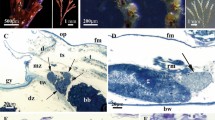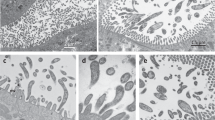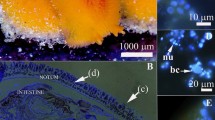Abstract
Earthworms of the family Lumbricidae harbor specific and stable populations of Acidovorax-like bacteria within their excretory organs, the nephridia. The symbionts of Eisenia foetida are deposited into the egg capsules during mating and the nephridia of the juveniles are colonized before they hatch. The timing and mechanisms governing bacterial recruitment and colonization are unknown for the earthworm-Acidovorax association. This study examined the process of colonization of the symbiotic organ during development of the embryos within the egg capsules. Bacteria associated with the developing embryos were visualized using in situ hybridization to bacterial cells and laser scanning confocal microscopy. Bacterial cells were associated with earthworm embryos during the earliest stages of development—the ova through to hatching. Three-dimensional examination of stages of development revealed an embryonic duct that recruits the Acidovorax-like symbiont cells. As each segment matures, Acidovorax-like symbiotic bacteria are recruited into this duct, excluding most other bacterial types, and remain there for a period of days prior to migration into the nephridium. After colonization of the nephridial ampulla, the canal remains bacteria-free. In addition to the known Acidovorax-like bacteria, multiple types of bacteria interact with the embryos externally and internally during the full course of development, and ultimately fill the gut lumen near the end of development prior to hatching. Colonization of the correct tissues by specific bacteria during differentiation and maturation of the organs must involve selective host defenses and signaling between the two partners to prevent over growth of nascent tissues.
Similar content being viewed by others
Log in or create a free account to read this content
Gain free access to this article, as well as selected content from this journal and more on nature.com
or
References
Amann RI, Krumholz L, Stahl DA . (1990). Fluorescent-oligonucleotide probing of whole cells for determinative, phylogenetic, and environmental studies in microbiology. J Bacteriol 172: 762–770.
Baumann P . (2005). Biology of bacteriocyte-associated endosymbionts of plant sap-sucking insects. Annu Rev Microbiol 59: 155–189.
Bettencourt R, Assefaw-Redda Y, Faye E . (2000). The insect immune protein hemolin is expressed during oogenesis and embryogenesis. Mech of Develop 95: 301–304.
Darwin C . (1889). The Formation of Vegetable Mould Through the Action of Worms, with Observations on their Habits. William Pickering: London.
Davidson SK, Koropatnick TA, Kossmehl R, Sycuro L, McFall-Ngai MJ . (2004). NO means ‘yes’ in the squid-vibrio symbiosis: nitric oxide during the initial stages of a beneficial association. Cell Microbiol 6: 1139–1151.
Davidson SK, Stahl DA . (2006). Transmission of nephridial bacteria of the earthworm, Eisenia fetida. Appl Environ Microbiol 72: 769–775.
Douglas AE . (1989). Mycetocyte symbiosis in insects. Biol Rev 64: 409–434.
Edwards CA (ed) (2004). Earthworm Ecology, 2nd edn. St Lucie Press/CRC Press: Boca Raton.
Egert M, Marhan S, Wagner B, Scheu S, Friedrich MW . (2004). Molecular profiling of 16S rRNA genes reveals diet-related differences of microbial communities in soil, gut, and casts of Lumbricus terrestris L. (Oligochaeta : Lumbricidae). FEMS Microbiol Ecol 48: 187–197.
Ereskovsky AV, Bouryesnault N . (2002). Cleavage pattern in Oscarella species (Porifera, Demospongiae, Homoscleromorpha): transmission of maternal cells and symbiotic bacteria. J of Nat Hist 36: 1761–1775.
Ereskovsky AV, Gonobobleva E, Vishnyakov A . (2005). Morphological evidence for vertical transmission of symbiotic bacteria in the viviparous sponge Halisarca dujardini Johnston (Porifera, Demospongiae, Halisarcida). Marine Biology 146: 869–875.
Foster JS, Apicella MA, McFall-Ngai MJ . (2000). Vibrio fischeri lipopolysaccharide induces developmental apoptosis, but not complete morphogenesis, of the Euprymna scolopes symbiotic light organ. Dev Biol 226: 242–254.
Furlong MA, Singleton DR, Coleman DC, Whitman WB . (2002). Molecular and culture-based analyses of prokaryotic communities from an agricultural soil and the burrows and casts of the earthworm Lumbricus rubellus. Appl Environ Microbiol 68: 1265–1279.
Gil-Turnes MS, Fenical W . (1992). Embryos of Homarus americanus are protected by epibiotic bacteria. Biol Bull 182: 105–108.
Gil-Turnes MS, Hay ME, Fenical W . (1989). Symbiotic marine bacteria chemically defend crustacean embryos. Science 246: 116–118.
Gorman MJ, Kankanala P, Kanost MR . (2004). Bacterial challenge stimulates innate immune responses in extra-embryonic tissues of tobacco hornworm eggs. Insect Mol Biol 13: 19–24.
Graf J, Dunlap PV, Ruby EG . (1994). Effect of transposon-induced motility mutations on colonization of the host light organ by Vibrio fischeri. J Bacteriol 176: 6986–6991.
Horn MA, Schramm A, Drake HL . (2003). The earthworm gut: an ideal habitat for ingested N2O-producing microorganisms. Appl Environ Microbiol 69: 1662–1669.
Ihssen J, Horn MA, Matthies C, Gössner A, Schramm A, Drake HL . (2003). N2O-producing microorganisms in the gut of the earthworm Aporrectodea caliginosa are indicative of ingested soil bacteria. Appl Environ Microbiol 69: 1655–1661.
Kaltenpoth M, Göttler W, Herzner G, Strohm E . (2005). Symbiotic bacteria protect wasp larvae from fungal infestation. Curr Biol 15: 475–479.
Knop J . (1926). Bakterien und Bakteroiden bei Oligochäten. Zoolgica Morphol Ökol Tiere 6: 588–624.
Lindquist N . (2002). Chemical defense of early life stages of benthic marine invertebrates. J Chem Ecol 28: 1987–2000.
Manz W, Amann R, Ludwig W, Wagner M, Schleifer KH . (1992). Phylogenetic oligodeoxynucleotide probes for the major subclasses of proteobacteria: problems and solutions. Syst Appl Microbiol 15: 593–600.
McFall-Ngai MJ . (2002). Unseen forces: the influence of bacteria on animal development. Devel Biol 242: 1–14.
McFall-Ngai MJ, Ruby EG . (2000). Developmental biology in marine invertebrate symbioses. Curr Opinion Microbiol 3: 603–607.
Nyholm SV, McFall-Ngai MJ . (2003). Dominance of Vibrio fischeri in secreted mucus outside the light organ of Euprymna scolopes: the first site of symbiont specificity. Appl Environ Microbiol 69: 3932–3937.
Nyholm SV, McFall-Ngai MJ . (2004). The winnowing: establishing the squid–vibrio symbiosis. Nature Rev Microbiol 2: 632–642.
Nyholm SV, Stabb EV, Ruby EG, McFall-Ngai MJ . (2000). Establishment of an animal-bacterial association: recruiting symbiotic vibrios from the environment. Proc Royal Soc of America 97: 10231–10235.
O'Neill S, Hoffman AA, Werren JH (eds) (1997). Influential passengers: Inherited Microorganisms and Arthropod Reproduction. Oxford University Press: Oxford.
Pernthaler J, Glöckner FO, Schönhuber W, Amann R . (2001). Fluorescence in situ hybridization (FISH) with rRNA-targeted oligonucleotide probes. In: Paul J (ed). Methods in Microbiology, vol. 30 Academic Press Inc.: San Diego. pp 207–226.
Pinel N, Davidson SK, Stahl DA . (2008). Verminephrobacter eiseniae gen. nov., sp. nov., a nephridial symbiont of the earthworm Eisenia foetida (Savigny). IJSEM (in press).
Roller C, Wagner M, Amann R, Ludwig W, Schleifer KH . (1994). In situ probing of Gram-positive bacteria with high DNA G + C content using 23S rRNA-targeted oligonucleotides. Microbiology 140: 2849–2858.
Schramm A, Davidson SK, Dodsworth JA, Drake HL, Stahl DA, Dubilier N . (2003). Acidovorax-like symbionts in the nephridia of earthworms. Envrion Microbiol 5: 804–809.
Schweitzer B, Huber I, Amann R, Ludwig W, Simon M . (2001). Alpha and beta-Proteobacteria control the consumption and release of amino acids on lake snow aggregates. Appl Environ Microbiol 67: 632–645.
Small AL, McFall-Ngai MJ . (1999). A halide peroxidase in tissues that interact with bacteria in the host squid Euprymna scolopes. J Cellul Biochem 72: 445–457.
Visick KL, Ruby EG . (1998). The periplasmic group III catalase of Vibrio fischeri is required for normal symbiotic competence and is induced both by oxidative stress and approach to stationary phase. J Bacteriol 180: 2087–2092.
Wheeler Alm E, Oerther DB, Larsen N, Stahl DA, Raskin L . (1996). The oligonucleotide probe database. Appl Environ Microbiol 62: 3557–3559.
Wilson EB . (1889). The embryology of the earthworm. J Morphology 3: 388–463.
Zachmann JE, Molina JAE . (1993). Presence of culturable bacteria in cocoons of the earthworm Eisenia fetida. Appl Environ Microbiol 59: 1904–1910.
Acknowledgements
We thank Steve McFarlane for the electron microscopy, and Wesley Tang for assistance with the cell counts in the egg capsules. We also thank Nic Pinel and Kristina Hillesland for giving helpful comments on the paper. This work was supported by NSF IOB 0345049.
Author information
Authors and Affiliations
Corresponding author
Additional information
Supplementary Information accompanies the paper on The ISME Journal website (http://www.nature.com/ismej)
Rights and permissions
About this article
Cite this article
Davidson, S., Stahl, D. Selective recruitment of bacteria during embryogenesis of an earthworm. ISME J 2, 510–518 (2008). https://doi.org/10.1038/ismej.2008.16
Received:
Revised:
Accepted:
Published:
Issue date:
DOI: https://doi.org/10.1038/ismej.2008.16
Keywords
This article is cited by
-
The draft genome of a new Verminephrobacter eiseniae strain: a nephridial symbiont of earthworms
Annals of Microbiology (2020)
-
The role of microbial motility and chemotaxis in symbiosis
Nature Reviews Microbiology (2019)
-
Unforeseen swimming and gliding mode of an insect gut symbiont, Burkholderia sp. RPE64, with wrapping of the flagella around its cell body
The ISME Journal (2018)
-
Diversity, structure and sources of bacterial communities in earthworm cocoons
Scientific Reports (2018)
-
The Microbiome of the Uropygial Secretion in Hoopoes Is Shaped Along the Nesting Phase
Microbial Ecology (2016)



